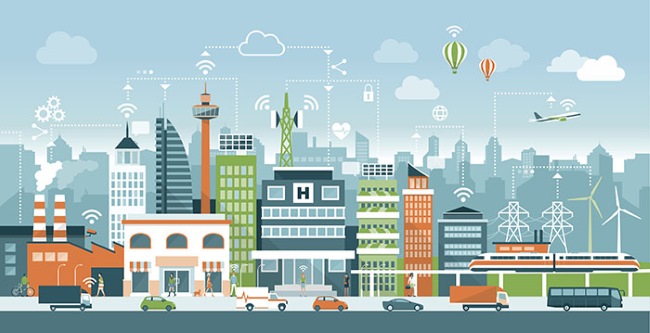The Internet of Things has seen rapid adoption in factories and on farms. However, the greatest benefits will be seen in micromanaging and eventually reducing the load on infrastructure in cities. We’re seeing IOT technology used to monitor the environment throughout cities, tracking variables from noise levels to air pollution to humidity. This data is used to better manage light levels, detect gunshots, and track down sources of pollution Yet the IOT networks being set up are often siloed, operating independently from each other. And any community trying to implement many digital systems need stable, scalable communication infrastructure
to handle the dramatically higher communication load. But what is the solution to that problem?

How Cities Can Handle the Digital Traffic Jam
We can compare the massive wave of digital communications that accompanies the IOT to an influx of traffic. Trying to maximize existing capacity only works until everything is a traffic jam. Building new highways, or in this case, a massive new wired network is daunting, expensive, disruptive and probably impractical. A wireless infrastructure, however, provides more flexibility and scalability. Furthermore, the wireless infrastructure doesn’t have to be built separately from the networked devices. Instead, the network drivers and controls can
be built into LED lights connected to the IOT as they are plugged into the power grid. On top of this, the smart LED lights can become extensions of the smart cities wireless mesh network, capturing and relaying data sent by smaller, mobile devices and stationary devices around it.
Why Isn’t Everyone Using LED Streetlights as the Backbone of the Civic IOT
LED lights plugged into the grid and forming the backbone of a civic Internet of Things is really only a skeleton. They can monitor a variety of other devices, since they will have continuous power and are high enough to cover a wide area. Adoption, though, is slowed by economics. Streetlights are designed to last years, so no one wants to rip them out to put “smart” ones in before they need to be replaced. Such an upgrade schedule will take decades.
Another issue is coverage. Street lights provide coverage on highways and busy thoroughfares. There is less coverage on small side streets and in suburban neighborhoods. Additional wireless infrastructure is thus still required to fill in the rest of the area.
Another factor to consider is support for the technology. Most cities don’t want to rely on a single vendor for all of their outdoor devices for decades, and no one has a one-size-fits-all solution. We don’t yet have an open, standard protocol for controlling everything from traffic signals to street lights to fire alarms. What if someone else comes up with a better IOT that does do everything? Others chose a vendor for smart LED street lights but cannot yet work with someone else to provide secondary connectivity.
Another concern slowing adoption of this technology except in siloed form is security. Street lights affect safety and quality of life. However, if they go out, that is a frustration. What happens if a still maturing civic network goes down, taking down everything from fire alarms to street lights? The potential savings from micromanaging the grid and tracking everything going on from a single control center is offset by the risk. Nor have we reached the point that cities can tie all their infrastructure to the cloud and consolidate departments with other cities and outsource to various service providers.
The Smart Way to Grow Smart Cities,





Pratik jain
Jun 04. 2019
a good point of view . a great blog, thank you for sharing this with us.
Carren
Nov 19. 2020
Thank you for sharing this useful and valuable article about smart cities